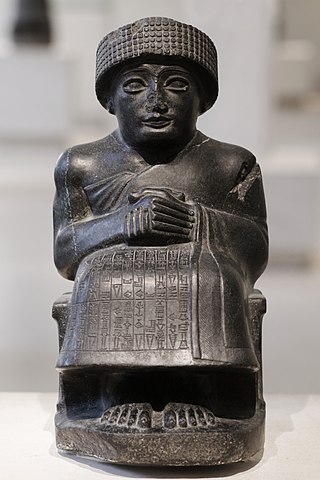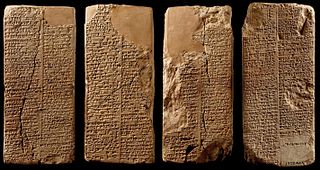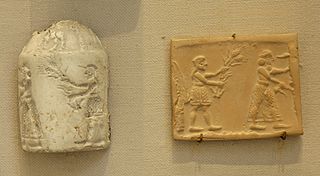
Gilgamesh was a hero in ancient Mesopotamian mythology and the protagonist of the Epic of Gilgamesh, an epic poem written in Akkadian during the late 2nd millennium BC. He was possibly a historical king of the Sumerian city-state of Uruk, who was posthumously deified. His rule probably would have taken place sometime in the beginning of the Early Dynastic Period, c. 2900 – 2350 BC, though he became a major figure in Sumerian legend during the Third Dynasty of Ur.

The Sumerian King List or Chronicle of the One Monarchy is an ancient literary composition written in Sumerian that was likely created and redacted to legitimize the claims to power of various city-states and kingdoms in southern Mesopotamia during the late third and early second millennium BC. It does so by repetitively listing Sumerian cities, the kings that ruled there, and the lengths of their reigns. Especially in the early part of the list, these reigns often span thousands of years. In the oldest known version, dated to the Ur III period but probably based on Akkadian source material, the SKL reflected a more linear transition of power from Kish, the first city to receive kingship, to Akkad. In later versions from the Old Babylonian period, the list consisted of a large number of cities between which kingship was transferred, reflecting a more cyclical view of how kingship came to a city, only to be inevitably replaced by the next. In its best-known and best-preserved version, as recorded on the Weld-Blundell Prism, the SKL begins with a number of fictional antediluvian kings, who ruled before a flood swept over the land, after which kingship went to Kish. It ends with a dynasty from Isin, which is well-known from other contemporary sources.

Inanna is an ancient Mesopotamian goddess of love, war, and fertility. She is also associated with beauty, sex, divine law, and political power. She was known by the Sumerians and Akkadians, Babylonians, and Assyrians as Ishtar. Her primary title was "the Queen of Heaven", and she was the patron goddess of the Eanna temple at the city of Uruk, which was her early main cult center. In archaic Uruk she was worshiped in three forms, morning Inanna (Inana-UD/hud), evening Inanna and princely Inanna, the former two reflecting the phases of the planet Venus which she was associated with. Her most prominent symbols included the lion and the eight-pointed star. Her husband was the god Dumuzid, and her sukkal, or personal attendant, was the goddess Ninshubur, who later became conflated with the male deities Ilabrat and Papsukkal.

The history of Sumer spans the 5th to 3rd millennia BCE in southern Mesopotamia, and is taken to include the prehistoric Ubaid and Uruk periods. Sumer was the region's earliest known civilization and ended with the downfall of the Third Dynasty of Ur around 2004 BCE. It was followed by a transitional period of Amorite states before the rise of Babylonia in the 18th century BCE.

Umma was an ancient city in Sumer. There is some scholarly debate about the Sumerian and Akkadian names for this site. Traditionally, Umma was identified with Tell Jokha. More recently it has been suggested that it was located at Umm al-Aqarib, less than 7 km (4.3 mi) to its northwest or was even the name of both cities. One or both were the leading city of the Early Dynastic kingdom of Gišša, with the most recent excavators putting forth that Umm al-Aqarib was prominent in EDIII but Jokha rose to preeminence later.

Adab or Udab was an ancient Sumerian city between Telloh and Nippur. It was located at the site of modern Bismaya or Bismya in the Wasit Province of Iraq.

Lugalbanda was a deified Sumerian king of Uruk who, according to various sources of Mesopotamian literature, was the father of Gilgamesh. Early sources mention his consort Ninsun and his heroic deeds in an expedition to Aratta by King Enmerkar.

Bad-tibira, "Wall of the Copper Worker(s)", or "Fortress of the Smiths", identified as modern Tell al-Madineh, between Ash Shatrah and Tell as-Senkereh in southern Iraq, was an ancient Sumerian city, which appears among antediluvian cities in the Sumerian King List. Its Akkadian name was Dûr-gurgurri. It was also called Παντιβίβλος (Pantibiblos) by Greek authors such as Berossus, transmitted by Abydenus and Apollodorus. This may reflect another version of the city's name, Patibira, "Canal of the Smiths".

Alulim was a mythological Mesopotamian ruler, regarded as the first king to ever rule. He is known from the Sumerian King List, Ballad of Early Rulers, and other similar sources which invariably place him in Eridu and assign a reign lasting thousands of years to him. The tablet of Old Babylonian period from Ur describing the divine appointment of Alulim by the gods notes that he was chosen among "vast and many people," and appointed by gods for the "shepherdship of the entirety of the many people". Another myth describing his appointment by the gods and incantations treating him as the creator of insects are also known. He is absent from Early Dynastic sources, and he is considered fictional by Assyriologists. His name was preserved in later Greek, Arabic and Persian works.

Enmebaragesi (Sumerian: 𒂗𒈨𒁈𒄄𒋛En-me-barag-gi-se [EN-ME-BARA2-GI4-SE]) originally Mebarasi (𒈨𒁈𒋛) was the penultimate king of the first dynasty of Kish and is recorded as having reigned 900 years in the Sumerian King List. Like his son and successor Aga he reigned during a period when Kish had hegemony over Sumer. Enmebaragesi signals a momentous documentary leap from mytho-history to history, since he is the earliest ruler on the king list whose name is attested directly from archaeology.
Enkimdu (𒀭𒂗𒆠𒅎𒁺) was a Mesopotamian god associated with agriculture and irrigation. He is best known from the poem Dumuzid and Enkimdu, but in laments he was instead connected with the god Martu, who like Dumuzi could be described and depicted as a shepherd.

Ninshubur, also spelled Ninšubura, was a Mesopotamian goddess whose primary role was that of the sukkal of the goddess Inanna. While it is agreed that in this context Ninshubur was regarded as female, in other cases the deity was considered male, possibly due to syncretism with other divine messengers, such as Ilabrat. No certain information about her genealogy is present in any known sources, and she was typically regarded as unmarried. As a sukkal, she functioned both as a messenger deity and as an intercessor between other members of the pantheon and human petitioners.
Duttur was a Mesopotamian goddess best known as the mother of Dumuzid. She frequently appears in texts mourning his death, either on her own or alongside Geshtinanna and Inanna. It is often assumed that she was associated with sheep.
Kuara is an archaeological site in Dhi Qar Province (Iraq). According to the Sumerian King List, Kuara was also the home of Dumuzid, the fisherman, the legendary third king of Uruk. The city's patron deity was Meslamtaea (Nergal). In Sumerian mythology, Kuara was also considered the birthplace of the god Marduk (Asarluhi), Enki's son. The cults of Marduk and Ninehama were centered in Kuara.

Dumuzid or Dumuzi or Tammuz, known to the Sumerians as Dumuzid the Shepherd, is an ancient Mesopotamian god associated with shepherds, who was also the first and primary consort of the goddess Inanna. In Sumerian mythology, Dumuzid's sister was Geshtinanna, the goddess of agriculture, fertility, and dream interpretation. In the Sumerian King List, Dumuzid is listed as an antediluvian king of the city of Bad-tibira and also an early king of the city of Uruk.

Meshkiangasher was a legendary king mentioned in the Sumerian King List as the priest of the Eanna temple in Uruk, whose journey led him to the enter the sea and ascend the mountains.
Enmerkar and En-suhgir-ana is a text in Sumerian literature appearing as a sequel to Enmerkar and the Lord of Aratta, and is second in a series of four accounts describing the contests of Aratta against Enmerkar, lord of Unug and Kulaba, and his successor Lugalbanda, father of Gilgamesh.
Inaros I of Athribis was an ancient Egyptian prince who rebelled against the Assyrians during their short-lived occupation of Egypt. His struggle against the Assyrians gave rise to a whole cycle of stories, known as The Inaros Stories, the latest of which date to the 2nd century AD, about 750 years after his death.
Grant Frame is a Canadian-American Assyriologist, Professor Emeritus of the University of Pennsylvania, and Curator Emeritus of the Babylonian Section of the University of Pennsylvania Museum of Archaeology and Anthropology. He is an expert on Akkadian language and literature and on the history and culture of ancient Mesopotamia in the first millennium BCE, in particular the Neo-Assyrian and Neo-Babylonian periods. Since 2008, he has served as Director and Editor-in-Chief of The Royal Inscriptions of the Neo-Assyrian Period (RINAP), an international research project funded by the U.S. government's National Endowment for the Humanities and other granting agencies, to translate the royal inscriptions of the rulers of Assyria from 744 to 609 BC. The RINAP project marks the continuation of the Royal Inscriptions of Mesopotamia (RIM) project, which Frame's teacher and mentor, Albert Kirk Grayson, founded at the University of Toronto in 1978 and led until his retirement with support from the Social Sciences and Humanities Research Council of Canada.
Tale of Gudam, also known as the Gudam Epic or Inanna and Gudam, is a Mesopotamian myth known from two Old Babylonian copies from Nippur. It tells the tale of Gudam, an otherwise unknown character, who goes on a rampage in Uruk. The minstrel Lugalgabagal criticizes his behavior, but his remarks only enrage him more. He is finally stopped by a fisherman of Inanna. The goddess herself subsequently decides to spare his life when he starts pleading, and sends him to live in a ditch near Zabalam. Many aspects of the story are a subject of debate in Assyriology, including the nature of Gudam and the identity of the fisherman. Possible connections between the Tale of Gudam and other texts have also been noted. In particular, Gilgamesh and the Bull of Heaven is considered a close parallel, with some authors outright considering the two texts to be variants of one narrative.


























